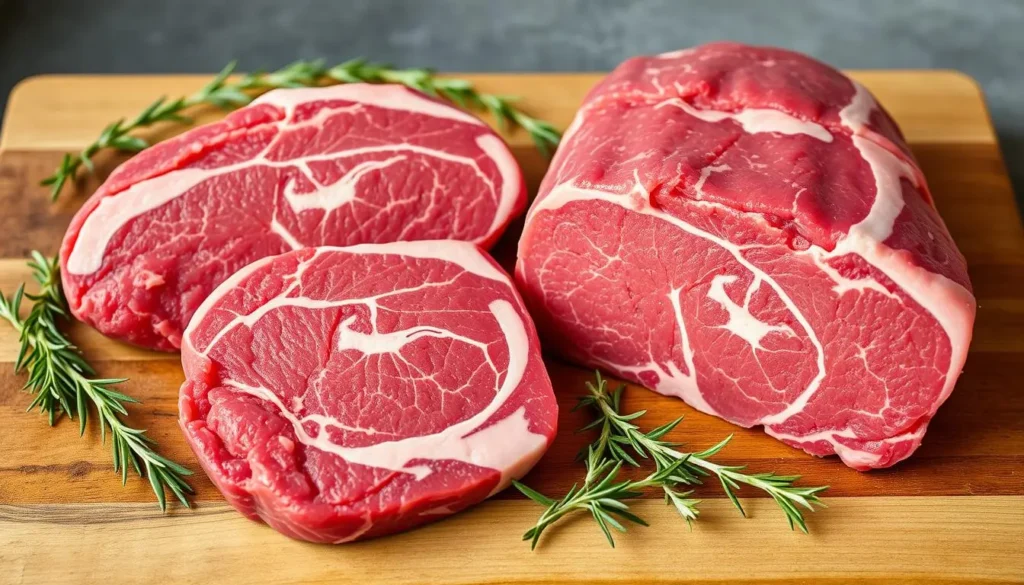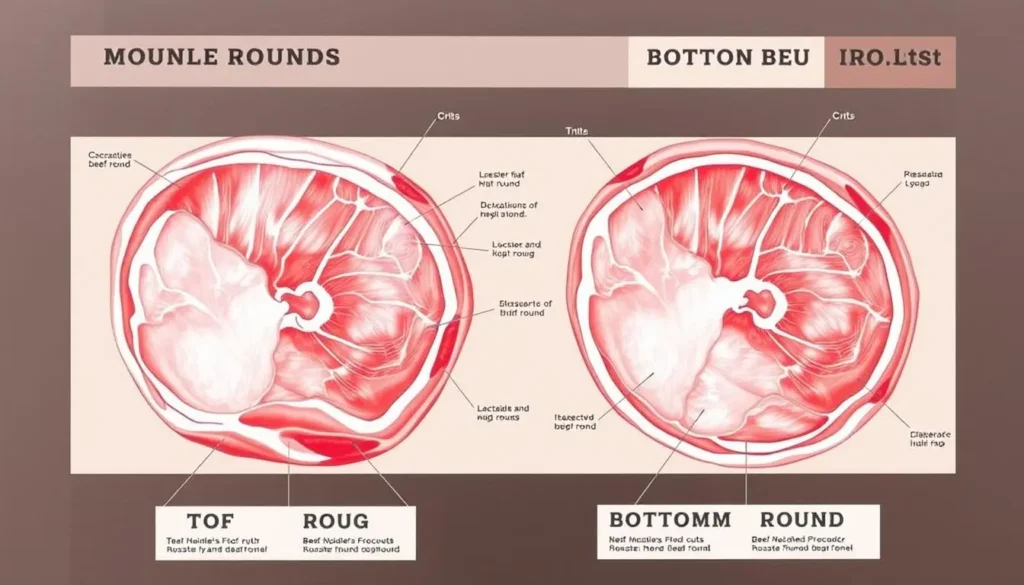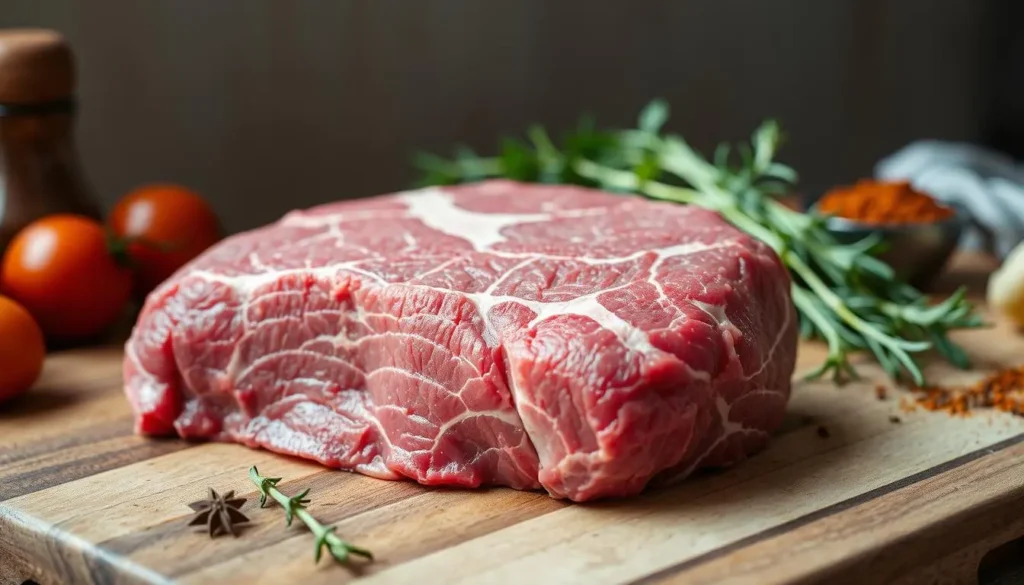When choosing the best beef cut, you might wonder about top round and bottom round. Knowing their differences is essential. You’ll learn about their location, muscle structure, and traits. This will help you compare these popular cuts.
Whether you’re a pro chef or a home cook, the right beef cut can elevate your dish. Top round and bottom round are both favorites. But which is better? In this article, you’ll discover what makes each cut unique. You’ll learn about their location, muscle structure, and traits to choose for your next meal.
Key Takeaways
- Understanding the differences between top round and bottom round beef cuts is crucial for selecting the right cut for your culinary needs.
- Top round and bottom round have distinct locations on the cow, which affect their muscle structure and composition.
- General characteristics of round cuts, such as tenderness and flavor, vary between top round and bottom round.
- Top round is known for its leaner profile, while bottom round is often preferred for its rich flavor.
- Both top round and bottom round can be used in a variety of dishes, from roasts to steaks.
- Choosing the right beef cut depends on your personal preferences and cooking style.

Understanding Beef Rounds: Basic Anatomy and Location
Beef rounds come from the cow’s rear section. This area is known for its tender and lean meat. The location of the round cuts on the cow affects the meat’s quality and taste.
The anatomy of beef rounds includes muscles like the semimembranosus and semictendinosus. These muscles help the cow move its hind legs. This means the meat is more tender and flavorful.
Location on the Cow
Beef rounds are found in the cow’s hindquarters, near the rump and thigh. This spot is great for high-quality beef rounds. It’s less likely to have fat and has a tender texture.
Muscle Structure and Composition
Beef rounds have a special mix of muscle fibers. This mix makes the meat tender and easy to cook. It’s less likely to become tough or chewy.
General Characteristics of Round Cuts
Round cuts are lean and tender, perfect for many dishes. They have low fat, a tender texture, mild flavor, and are versatile in cooking.
- Low fat content
- Tender texture
- Mild flavor
- Versatile cooking options
Knowing about beef rounds’ anatomy and location helps you pick the right cut. Whether for a special occasion or everyday meals, beef rounds are a great choice.
| Beef Round Cut | Location on the Cow | Muscle Structure |
|---|---|---|
| Top Round | Hindquarters | Semimembranosus muscle |
| Bottom Round | Hindquarters | Semictendinosus muscle |
The Distinctive Features of Top Round
When you explore beef cuts, top round is a top choice for chefs and home cooks. It has unique features like texture, flavor, and tenderness. Plus, it’s lean, making it a healthier beef option.
Top round’s features include:
- Fine texture, perfect for slicing thinly
- Mild flavor, great for absorbing marinades and seasonings
- Exceptional tenderness for a great dining experience
These features make top round ideal for dishes like stir-fries and roasts. Knowing its unique characteristics is key. This way, you can make delicious meals that showcase this exceptional beef cut.
Compared to other cuts, top round offers a special mix of flavor, texture, and tenderness. As you explore more beef options, you’ll see top round is versatile and exciting. Its unique features and many cooking options make it a favorite among beef lovers.
Bottom Round Characteristics and Uses
Bottom round is a lean cut of meat that’s popular for many dishes. It’s great for those watching their fat intake. You can use it in roasts, steaks, and even stir-fries.
It’s also known as the outer round and round primal cut. It usually weighs 10-15 pounds. The price and availability can vary based on where you are and the cut.
Common Names and Labels
- Outer round
- Round primal cut
- Bottom round roast
Bottom round is tender and flavorful, making it versatile. It’s perfect for roasts or hearty steaks. Its affordability and wide availability make it a favorite among chefs and home cooks.
Compared to other beef cuts, bottom round is more affordable. You can find it in most supermarkets and butcher shops. Its characteristics and uses make it a great choice for adding variety to your meals.
Is Top Round or Bottom Round Better? A Detailed Comparison
Choosing between top round and bottom round requires a detailed look. You should think about texture, fat content, and price. This will help you pick the right cut for your cooking needs.
Texture is a key factor. Top round is tender and lean, perfect for dishes where beef flavor shines. Bottom round, with more fat, adds flavor to your meals.
Texture Differences
Top round is great for steaks and roasts. Bottom round works well for slow-cooked dishes like stews. The fat content affects both texture and flavor.
Fat Content Analysis
Bottom round’s higher fat makes it more tender, even with different cooking methods. Top round is pricier but leaner, making it tender if cooked right.
Price Comparison
The price difference might not be big enough to decide for you. Both cuts can be cooked to perfection. Your choice depends on your taste and cooking style.
Mastering Bottom Round Roast Preparation
To make a tasty bottom round roast, you must know how to cook it right. The secret to a tender and flavorful roast lies in how you prepare it. This includes picking the right meat, seasoning it well, and cooking it just right.
When cooking a bottom round roast, there are a few things to keep in mind. Here are some tips to get you started:
- Look for a roast with a mix of marbling and lean meat for the best taste and texture.
- Season the roast well with salt, pepper, and your favorite herbs and spices.
- Cook the roast in a hot oven at a moderate temperature for even cooking.
A perfectly cooked bottom round roast is a show-stopper. With the right preparation and cooking, you can make a roast that’s both tender and full of flavor. Whether it’s for a special event or a simple dinner, a bottom round roast will wow your guests.
| Cooking Method | Temperature | Cooking Time |
|---|---|---|
| Oven Roasting | 325°F (165°C) | 2-3 hours |
| Slow Cooking | 275°F (135°C) | 4-5 hours |
By using these tips and techniques, you can become a pro at bottom round roast preparation. You’ll create a meal that’s not only delicious but also memorable.
Optimal Cooking Methods for Both Cuts
Understanding the best cooking methods for top round and bottom round is key. These methods help make your beef tender and full of flavor. You can use dry heat and moist heat to get the best results.
Dry heat, like grilling or pan-frying, creates a crispy outside and a juicy inside. Moist heat, such as braising or stewing, makes the meat tender and easy to chew. This is because it breaks down the meat’s connective tissues.
Cooking Techniques to Consider
- Dry heat methods: grilling, pan-frying, or broiling
- Moist heat techniques: braising, stewing, or slow cooking
It’s important to follow temperature guidelines, no matter the method. This ensures your food is safe and tastes great. By trying different methods, you’ll find the best way to cook your beef.
Knowing your beef cuts well is the first step to great cooking. With time and effort, you’ll master cooking top round and bottom round. Your dishes will impress everyone.
Understanding Cooking Times and Tenderness
When cooking top round or bottom round, cooking times are key to tenderness. You must know how cooking times and tenderness relate. This includes the roast’s size, thickness, and desired doneness.
A general guideline for cooking times is as follows:
- For medium-rare, cook for 15-20 minutes per pound
- For medium, cook for 20-25 minutes per pound
- For medium-well, cook for 25-30 minutes per pound
Also, check the roast’s internal temperature. It should be 130-135°F for medium-rare, 140-145°F for medium, and 150-155°F for medium-well. Knowing these cooking times and temperatures helps you achieve the right tenderness.
Remember, getting it right takes practice. Don’t worry if it takes a few tries. With patience and practice, you’ll soon cook like a pro. You’ll get the perfect cooking times and tenderness for your roast.
| Cooking Method | Cooking Time | Internal Temperature |
|---|---|---|
| Roasting | 15-30 minutes per pound | 130-155°F |
| Grilling | 5-10 minutes per side | 130-155°F |
Best Uses for Each Cut in American Cuisine
In American cooking, top round and bottom round are both very useful. Top round is great for steaks, roasts, or even thin sandwiches. Bottom round is best for stews, soups, or braises.
Top round is perfect for traditional dishes like steak salads, wraps, or subs. Its lean meat is perfect for these dishes. Bottom round, with its richer taste, is great for comfort food like beef stew or pot roast.

Top Round Applications
- Steak salads with mixed greens and tangy dressings
- Thinly sliced sandwiches with melted cheese and caramelized onions
- Grilled steak with roasted vegetables and quinoa
Bottom Round Dishes
- Hearty beef stew with root vegetables and crusty bread
- Braised pot roast with mashed potatoes and steamed broccoli
- Beef and vegetable soup with a side of crusty bread
Both top round and bottom round can make delicious American dishes. With a bit of creativity, you can make many recipes that highlight each cut’s unique qualities.
Tips for Selecting Quality Round Cuts
Choosing the right round cuts is key. Look for meat with a good mix of marbling and tenderness. Marbling is the fat in the meat, which affects taste and texture.
A quality round cut should have just the right amount of marbling. This keeps the meat juicy and full of flavor. Opt for “prime” or “choice” labels for better quality. Here are some tips to help you choose:
- Choose cuts with a good balance of marbling and tenderness
- Look for labels such as “prime” or “choice”
- Consider the intended use of the meat, such as grilling or roasting
By following these tips, you’ll get the best round cuts for your needs. Whether you’re a pro chef or a home cook, picking quality cuts is essential.
Remember, the key to great round cuts is understanding what makes your dish better. With practice, you’ll pick the perfect cuts for delicious, tender meat every time.
| Cut of Meat | Marbling | Tenderness |
|---|---|---|
| Top Round | Moderate | Tender |
| Bottom Round | Less | Less Tender |
Storage and Handling Recommendations
Storing and handling round cuts right is key to keeping them fresh and safe. You want your bottom round roast recipe to be tender and delicious. Start by storing them in a sealed container or plastic bag, squeezing out air before sealing.
It’s also important to handle the meat clean to avoid contamination. Always use clean hands and tools when handling the meat. Store them in the fridge at a temperature below 40°F (4°C). Freezing is another good option for longer storage.
Proper Storage Methods
- Store in a sealed container or plastic bag
- Keep in the refrigerator at a consistent temperature below 40°F (4°C)
- Separate from other foods to prevent cross-contamination
Freezing Guidelines
Freezing is great for keeping round cuts for a while. Wrap them tightly in plastic wrap or foil, then in a freezer-safe bag. Don’t forget to label the bag with the date and what’s inside. Store it in the freezer at 0°F (-18°C) or below.
Thawing Techniques
When you’re ready to use your frozen round cuts, thaw them safely. You can thaw them in the fridge, in cold water, or in the microwave. Always cook them to the recommended internal temperature for food safety. By following these tips, you can enjoy your bottom round roast recipe and other round cut dishes for longer, keeping them fresh and tasty.

Conclusion: Making the Right Choice for Your Cooking Needs
Top round and bottom round are both excellent for various dishes. Think about your cooking preferences and the meal you’re planning. Top round is lean and tender, ideal for quick cooking.
On the other hand, bottom round is perfect for slow-cooked meals like pot roasts. It becomes tender with longer cooking times.
Choosing the right cut is key to better cooking. Whether it’s a simple dinner or a big event, the right cut matters. Look for bottom round roast, also known as rump roast, in stores.
With this knowledge, you can confidently choose the best beef for your meal. You’ll enjoy delicious results.
FAQ
What is a bottom round roast good for?
A bottom round roast is great for many dishes. It’s perfect for roasts, stews, and slow-cooked meals. This cut is lean and flavorful, making it tender and juicy with moist heat cooking.
Does a bottom round roast get more tender the longer you cook it?
Yes, a bottom round roast gets more tender with longer cooking. Its tough fibers need time to soften. Braising or slow roasting are best for tender results.
What is another name for a bottom round roast?
A bottom round roast is also known as a rump roast. It’s also called a round tip roast or simply a round roast. These names all point to the same beef cut from the cow’s rear leg.

